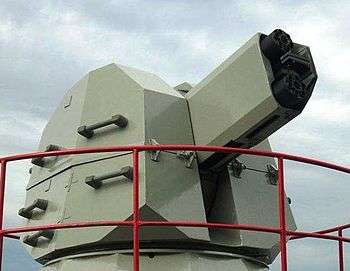AK-630
| AK-630 | |
|---|---|
|
AK-630M-2 Duet with low RCS turret (the most recent variant of the system) | |
| Type | Close-in weapon system |
| Place of origin | Soviet Union, Russia |
| Service history | |
| In service | 1976–present[1][2] |
| Used by | See Operators |
| Production history | |
| Designer |
Developer: TsKIB SOO (Mikhail Knebelman;[1][3] Vasily Bakalev (AK-630M1-2))[4] Cannon: KBP Instrument Design Bureau (Vasily Gryazev, Arkady Shipunov)[1] Fire control system: Zavod Topaz (V. P. Yegorov):[1][5] Vympel MR-123, Vympel-A MR-123/176 Ametist Design Bureau:[1] Vympel-AM MR-123-02/MR-123-03, Vympel-AME MR-123-02/176 |
| Designed |
1963–1973 (AK-630)[1] 1983–1989 (1993) (AK-630M1-2)[6] |
| Manufacturer | Tulamashzavod[1] |
| Produced | 1972–present[5] |
| Number built | More than 1000[2] |
| Variants |
AK-630M, AK-630M1; AK-306 (non-CIWS); AK-630M1-2, AK-630M-2 Duet |
| Specifications | |
| Weight |
Gun mount: 1,000 kg (2,200 lb) (AK-630)[1] 1,800 kg (4,000 lb) (AK-630M)[1][7] 2,500 kg (5,500 lb) (AK-630M-2)[1] External nodes: 800 kg (1,800 lb) (AK-630)[1] 2000 rounds in belt: 1,918 kg (4,228 lb)[1] Fire control system: ? (Vympel MR-123) ? (Vympel-A MR-123/176) 5.2 tonnes (5.7 short tons) (Vympel-AM MR-123-02/MR-123-03 and Vympel-AME MR-123-02/176)[1] 1 tonne (2,200 lb) (Laska 5P-10E)[1] |
| Barrel length |
1,629 mm (64 in) (total)[1] 1,460 mm (57 in) (rifled)[1] |
| Width | 1,240 mm (49 in) (mount ring)[1] |
| Height |
1,070 mm (42 in) (above deck)[1] 2,050 mm (81 in) (below deck)[1] |
| Crew | 1 |
|
| |
| Shell | HEI-Frag, Frag-T[1] |
| Shell weight | 0.39 kg (0.86 lb)[1] |
| Caliber | 30×165mm AO-18[N 1] |
| Barrels | 6 (× 2) |
| Action | Gas-operated rotary cannon |
| Elevation |
+88° ... -12° (50°/sec)[1] +90° ... -25° (60°/sec) AK-630M-2[8] |
| Traverse |
±180° (70°/sec)[1] ±180° (80°/sec) AK-630M-2[8] |
| Rate of fire | 4,000–10,000 rounds/min[6][7] |
| Muzzle velocity | 880–900 m/s (2,900–3,000 ft/s)[1] |
| Effective firing range |
4,000 m (13,000 ft) (aerial)[1] 5,000 m (16,000 ft) (maritime)[1] 5,000 m (16,000 ft) (all) AK-630M-2[9] |
| Maximum firing range | the projectiles self-destruct past 5,000 m (16,000 ft) range[1] |
| Feed system | Belt, 2,000–4,000 rounds[1] |
| Sights | Radar / TV-optical |
|
| |
Main armament | 1 or 2 AO-18 autocannons |
Secondary armament | 4 9A4172 missiles (Vikhr-K upgrade)[10] |
The AK-630 is a Soviet and Russian fully automatic naval close-in weapon system based on a six-barreled 30 mm rotary cannon. In "630", "6" means 6 barrels and "30" means 30 mm. It is mounted in an enclosed automatic turret and directed by radar and television detection and tracking. The system's primary purpose is defense against anti-ship missiles and other precision guided weapons. However it can also be employed against fixed or rotary wing aircraft, ships and other small craft, coastal targets, and floating mines. Once operational, this weapon system was rapidly adopted, with up to 8 units installed in every new Soviet warship (from mine-hunters to aircraft carriers), and hundreds produced in total.
Description
The complete weapon system is called A-213-Vympel-A, which comprises the AK-630M Gun Mount, MR-123-02 Fire Control Radar System, and SP-521 Electrical-Optical Tracker. A single MR-123 radar system can simultaneously control two guns, either two 30 mm gun mounts, or two 57 mm gun mounts, or one 30 mm gun and one 57 mm gun. The radar system can engage aerial and surface targets at 4 km and 5 km respectively. The electro-optical system can detect a MiG-21–sized aerial target 7 km away, while torpedo boat–sized surface targets can be detected at a range of up to 70 km. Features include surveillance and tracking modes, high jamming immunity, laser range finder and TV optical sight. It is in operation on almost all Russian Navy ships from fast attack boats to the Kirov battlecruiser.
The gun mount is fully automated, and can also be remotely controlled by an operator from either the control console or via a remotely mounted gunsight. It has a higher firing rate than both the Goalkeeper and Phalanx (Block 1 and older) CIWS models. They are often mounted in pairs, with as many as four pairs mounted on the larger ships, providing an effective point defence (last) layer. However, like all gun-based CIWS, they suffer from short engagement times and the need for multiple volleys to effectively eradicate a threat.
Development
The AK-630 CIWS is composed of several members and sometimes the CADS-N-1 Kashtan's sub-systems and its derivatives are also included.
AK-630
The design of the AK-630 CIWS was initiated in 1963, with the first operational prototype completed in 1964. Trials of the complete system, including radar and controls went on until 1976 when the system was accepted for service.
AK-630M
During the deployment of the system, numerous problems that did not appear in trials were exposed in its application, and some modification of the original AK-630 was made to correct these problems, and in 1979, the new system was named as AK-630M and was accepted into service.
AK-306
A derivative of AK-630M was developed for light craft and this system was named as AK-306. Externally, the air-cooled AK-306 can be distinguished from the AK-630 by the absence of the water cooling system (a cylindrical jacket that surrounds the barrel cluster of the AK-630). Internally, the AK-306 (A-219) used electricity to power the automatics, instead of using the exhaust. This version also lacked radar control, being only optically guided, hence making it less of an anti-missile weapon and more of a surface-to-surface weapon, and the designation of the overall system is consequently changed from A-213-Vympel-A to A-219. The design started in 1974 and the system was accepted into service in 1980. When production was completed in 1986, 125 systems were in service.
AK-630M1-2
In 1983, a decision was made to update the design and modify the AK-630 system to include a second gun mounted above the first, which provides 10,000 rpm in total. The AK-630M1-2 "Roy" was roughly the same size and weight allowing installation in existing AK-630 mounts. Though the system proved to be successful, the AK-630M1-2 Roy was not accepted for production due to the maturity of a combined missile and gun system, then designated the 3M87 Kortik, but later called Kashtan. The single example of AK-630M1-2 Roy remains installed on the Project 206.6 class missile boat # P-44.
In July 2007 at IMDS-2007, a modernized version of the AK-630M1-2 was showcased by OAO AK Tulamashzavod under the new name "Duet". Visually "Duet" differs from "Roy" in having a new mount with a stealthy low RCS design compared with the more traditional rounded AK-630 mounts.
In 2012 it was announced that the new Ivan Gren-class landing ship would be armed with the modified AK-630M-2 system.[11]
Comparison with current CIWS
| |
|
|
|
| |
|---|---|---|---|---|---|
| Weight | 9,114 kg (20,093 lb) | 11,819 kg (26,056 lb) | 6200 kg (13,700 lb, incl. in-built radars) | 9,902 kg (21,830 lb) | 5,500 kg (12,100 lb) |
| Armament | 30 mm (1.2 in) 6 barreled GSh-6-30 rotary cannon | 2 × 30 mm (1.2 in) 6 barreled GSh-6-30 rotary cannon | 20 mm (0.79 in) 6 barreled M61 Vulcan rotary cannon | 30 mm (1.2 in) 7 barreled GAU-8 rotary cannon | 40 mm (1.6 in) 2 barreled Bofors 40 mm |
| Rate of Fire | 5,000 rounds per minute | 10,000 rounds per minute | 4,500 rounds per minute | 4,200 rounds per minute | 600/900 rounds per minute (optionally : proximity-fused rounds) |
| (effective/ flat-trajectory) Range | 4,000 m (13,000 ft) | 4,000 m (13,000 ft) | 3,600 m (11,800 ft) | 2,000 m (6,600 ft) | 4,000 m (13,000 ft) |
| Ammunition storage | 2,000 rounds | 4,000 rounds | 1,550 rounds | 1,190 rounds | 736 rounds |
| Muzzle velocity | 900 m (3,000 ft) per second | 900 m (3,000 ft) per second | 1,100 m (3,600 ft) per second | 1,109 m (3,638 ft) per second | 1,000 m (3,300 ft) per second |
| Elevation | −12 to +88 degrees | −25 to +90 degrees | −25 to +85 degrees | −25 to +85 degrees | −13 to +85 degrees |
| Traverse | ±180 degrees | ±180 degrees | ±180 degrees | 360 degrees | 360 degrees |
Operators

Current operators
 Algerian National Navy on Steregushchy-class corvette
Algerian National Navy on Steregushchy-class corvette Bulgaria
Bulgaria Burma
Burma Cameroon
Cameroon People's Republic of China[12]
People's Republic of China[12] Croatia
Croatia Cuba
Cuba India[1][12]
India[1][12] Indonesia
Indonesia Greece
Greece Pakistan
Pakistan Poland[1]
Poland[1] Romania
Romania Russia[1][12]
Russia[1][12] Slovenia[12]
Slovenia[12]-
 North Korea
North Korea  Ukraine[12]
Ukraine[12] Vietnam
Vietnam Yemen
Yemen Kenya
Kenya
Former operators
See also
References
- Notes
- ↑ Not compatible with the army 30×165mm ammunition – different primers, powder sorts and loads, and fuzes are used.
- Citations
- 1 2 3 4 5 6 7 8 9 10 11 12 13 14 15 16 17 18 19 20 21 22 23 24 25 26 27 28 29 30 31 32 33 "30 mm AK-630 System". MilitaryRussia.ru (in Russian). 19 January 2009 – 4 July 2010. Retrieved 22 March 2013.
- 1 2 АК-630, корабельная автоматическая 30-мм артиллерийская шестиствольная установка. Arms-Expo.ru (in Russian). Информационное агентство «Оружие России». Archived from the original on December 31, 2012. Retrieved 31 March 2013.
- ↑ "Mikhail Samoilovich Knebelman (1910–1999)" (in Russian). KBP Instrument Design Bureau. 2010. Retrieved 22 March 2013.
- ↑ Shirokorad, Aleksandr (30 December 2011). От артустановки АК-230 до серий АК-630 и АК-630М. Nezavisimoye Voyennoye Obozreniye (in Russian). Retrieved 23 March 2013.
- 1 2 "30 mm Six-barrel Automatic Systems AK-630 and AK-630M". История современной зенитной ПВО России (in Russian). Retrieved 22 March 2013.
- 1 2 3 "30 mm AK-630M1-2 / AK-630M-2 System". MilitaryRussia.ru (in Russian). 13 March 2009 – 13 July 2011. Retrieved 23 March 2013.
- 1 2 "30-mm AUTOMATIC GUN MOUNT AK-630М". Tulamashzavod. Archived from the original on 24 August 2012. Retrieved 23 March 2013.
- 1 2 "AK-630M-2 Duet CIWS". YouTube. Retrieved 26 November 2014.
- ↑ "10000 выстрелов в минуту". Voyennaya Taina (in Russian). 16 April 2011. 3:20 [35:30] minutes in. REN TV.
- ↑ "Вихрь-К", корабельный высокоточный зенитный ракетно-артиллерийский комплекс. Arms-Expo.ru (in Russian). Информационное агентство «Оружие России». Archived from the original on 25 April 2012. Retrieved 30 March 2013.
- ↑ Glukhov, Dmitry (15 March 2012). Технический облик десантного корабля "Иван Грен" не определен. ФлотПром (in Russian). Центральный Военно-Морской Портал. Retrieved 23 March 2013.
- 1 2 3 4 5 6 7 "AK-630 Gatling Gun Close in Weapon System". Indian-Military.org. 12 March 2010. Archived from the original on 15 March 2010.
- ↑ Dan Petty. "The US Navy -- Fact File:". U.S. Navy. Retrieved 26 November 2014.
- ↑ "Italy 40 mm/70 (1.57") Breda". navweaps.com. Retrieved 26 November 2014.
External links
| Wikimedia Commons has media related to AK-630 CIWS. |
- English
- Russian
- 30 мм установка АК-630 – Military Russia
- 30 мм установка АК-630М1-2 / АК-630М-2 – Military Russia
- 30-мм АВТОМАТИЧЕСКАЯ УСТАНОВКА АК-630М1-2 «РОЙ» – Вестник ПВО
- АК-630, корабельная автоматическая 30-мм артиллерийская шестиствольная установка – Оружие России
